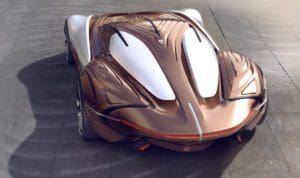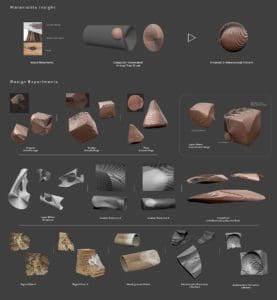Materiality in Design
January 15, 2020What if a car consumer could experience the beauty and joy of precious natural materials in a sustainable way? That’s the question Sung Kim’s MFA thesis project set out to answer.
Often the alternative to using, and recycling, artificial materials is the judicious use of natural materials. Wood, for example. We love it for its texture, its heft and solidity, the grain and color — its materiality. In research he conducted for his CCS graduate thesis, Sung Hyun Kim (’19, MFA Transportation Design) discovered that many people respond emotionally and psychologically to a material’s properties before they can even identify the material itself. In order to be environmentally friendly, however, we should plant a tree for every one that’s cut. But what if a consumer — say, a car driver — could experience the beauty and joy of precious natural materials in a sustainable way? That’s the question Kim’s thesis project set out to answer.

Sung Kim, Digital
When Tesla Motors introduced its Model S sport sedan in 2012, the car — and, indeed, the company — became a game changer in the luxury car market: uniquely purpose-built as an electric vehicle, the Model S was designed from the wheels up to be efficient and modern but also sustainable. Teslas have attained cult status among environmentally conscious drivers, but the cars’ greatest contributions are for what’s under the hood: a fully electric powertrain and battery, fast charging time and remarkable mph, aerodynamic design and simplified propulsion system. And a body made mostly of aluminum and steel.
During his thesis project’s research phase, Sung Kim studied Tesla and wondered how to design a luxury vehicle with the beauty of natural materials that avoided the often hard-to-recycle painted steel body of most cars, even environmentally conscious ones.
“We love natural materials. But they are too precious to waste. We need to find a better way of enjoying beloved natural materials by using and reinventing materiality extracted from natural materials,” Kim explained. “In the era of sustainable living, we can use highly-developed artificial materials that infuse reclaimed and renewable materials with technology and artistry to deliver a rich sensory experience that is beyond what authentic materials provide — while we enjoy the added benefit of being responsible towards our environment.”

Sung Kim, Digital
Using wood as a metaphor, Kim created computer-generated, virtual tree trunks, extruding them via 3D printer. “Then, just as a carpenter cuts a piece of log into shape, I cut the virtual tree trunks into various shapes, from basic geometries, into complex speed forms.” He used the shapes, made of fully recyclable plastic, to conduct multiple experiments exploring the material’s “wood-ness” (what he calls Nature+): pattern, texture, pliability, thickness and more. Take, for example, the electric Hyper-GT, a concept car that is meant to be extremely fast even as it is made of heavy machinery. Kim drafted multiple variations of the Hyper-GT Concept and found that he could express the materiality of wood in a luxury car format. Light, flexible and sporty.
Future experiments will look at how the recycled plastic can be applied to a car’s various functional elements, as well as the materiality of other natural materials. For now, Kim maintains that the general consumer does not have to sacrifice the desire to experience the properties of natural materials while using artificial ones. “It doesn’t have to mean the extravagant use of scarce, natural materials,” he explained. “With the concept of materiality, we can enjoy nature without wasting it.”
